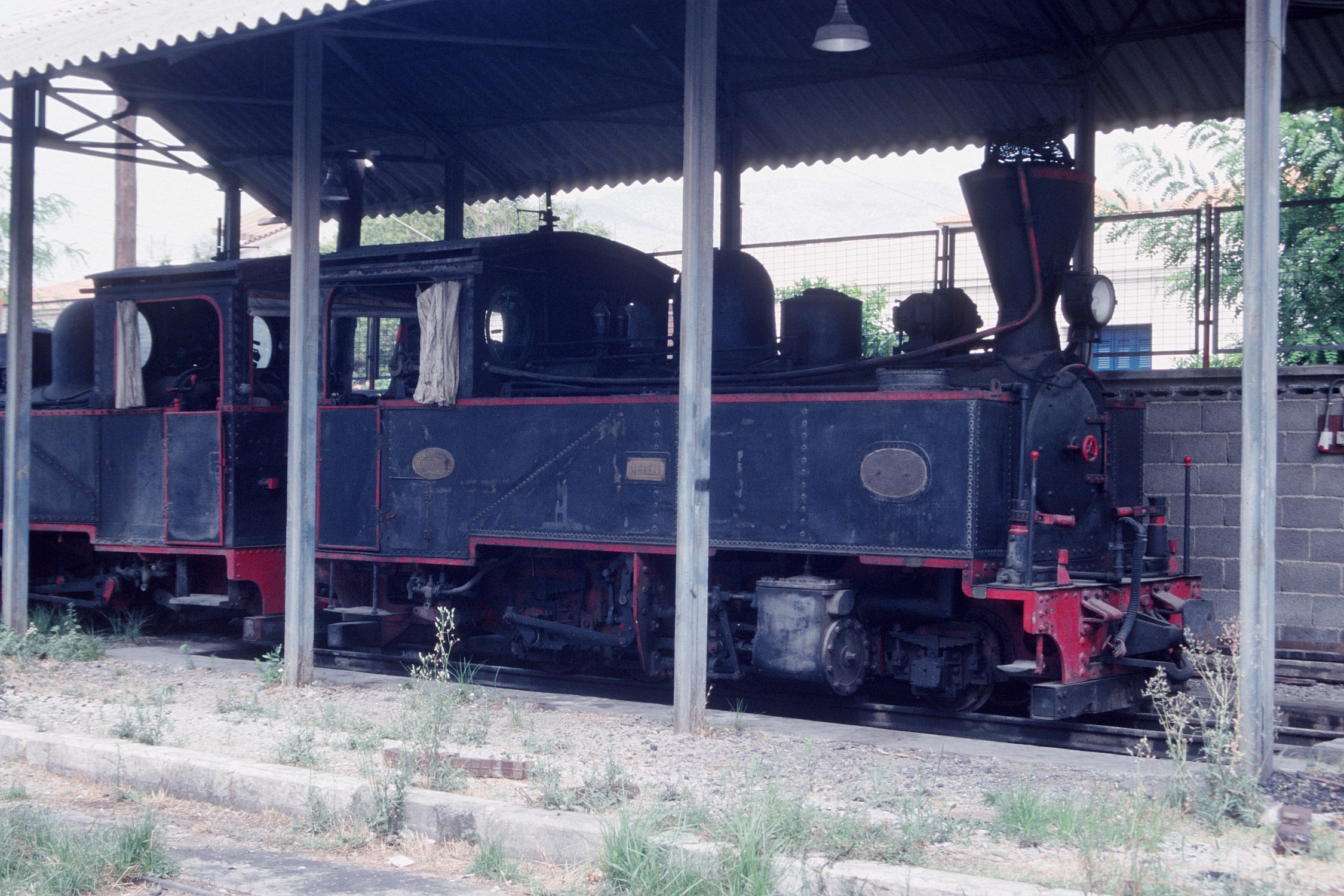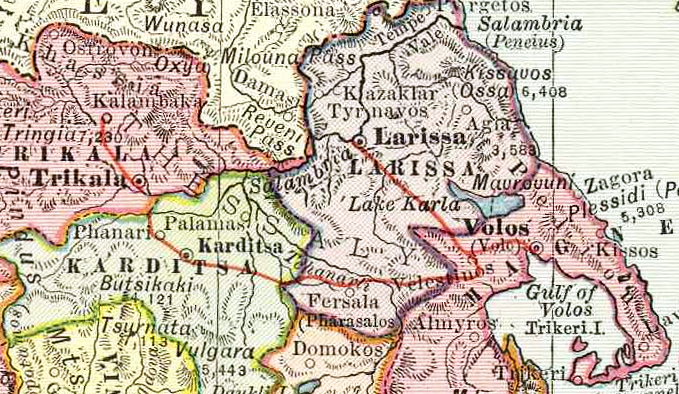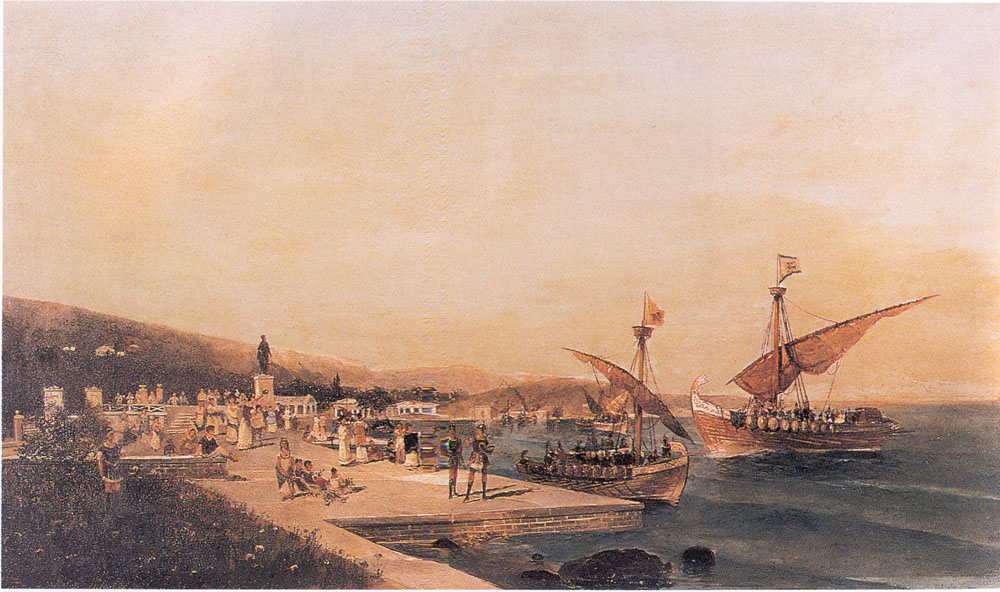|
Pelion Railway
Pelion railway is a narrow gauge railway line of Thessaly Railways in Greece, connecting the city of Volos with the town of Mileai on Pelion. History After Thessaly Railways completed the construction of the lines from Volos to Larissa and Kalampaka (1886) they decided to extend their network eastwards, to connect Volos with the communities of Pelion Peninsula. Due to limited space and mountainous terrain they decided to build this extension in narrow gauge. The new line extended from Volos station through Volos city centre (as a tramway) to Agria (1892), reaching Ano Lechonia in 1896 and Mileai (Milies) in 1903. The section from Volos station to Anavros is essentially a tramway. In addition to Pelion trains, tram services have operated in the past on this section. From Anavros to Agria and Lechonia the line has no special features, most notable being the concrete bridge over River Vrychon. In contrast, the mountain section from Ano Lechonia to Mileai has a number of interes ... [...More Info...] [...Related Items...] OR: [Wikipedia] [Google] [Baidu] |
Narrow Gauge Railway
A narrow-gauge railway (narrow-gauge railroad in the US) is a railway with a track gauge narrower than standard . Most narrow-gauge railways are between and . Since narrow-gauge railways are usually built with tighter curves, smaller structure gauges, and lighter rails, they can be less costly to build, equip, and operate than standard- or broad-gauge railways (particularly in mountainous or difficult terrain). Lower-cost narrow-gauge railways are often used in mountainous terrain, where engineering savings can be substantial. Lower-cost narrow-gauge railways are often built to serve industries as well as sparsely populated communities where the traffic potential would not justify the cost of a standard- or broad-gauge line. Narrow-gauge railways have specialised use in mines and other environments where a small structure gauge necessitates a small loading gauge. In some countries, narrow gauge is the standard; Japan, Indonesia, Taiwan, New Zealand, South Africa, and the A ... [...More Info...] [...Related Items...] OR: [Wikipedia] [Google] [Baidu] |
Thessaly Railways
Thessaly Railways ( el, Σιδηρόδρομοι Θεσσαλίας) was a railway company in Greece, which owned and operated the metre gauge railway network of Thessaly and Pelion railway from 1884 to 1955, when the company was absorbed by the Hellenic State Railways. Today the term usually refers to the section of mainline between Domokos and Rapsani and its two branches, the West Thessaly branch to Kalambaka and the Volos branch. Network and stations The network of Thessaly Railways consisted of the following lines: * Volos—Velestinon. The line extended from Volos station to the city centre along Dimitriados Street. * Velestinon—Kalampaka, connecting with the Athens-Larissa-Thessaloniki standard gauge mainline at Palaiofarsalos. This section had a maximum gradient of 3% between Velestinon and Aerinon. * Velestinon—Larissa, terminating to the Thessaly Railways station, next to the mainline (standard gauge) station. * Volos—Mileai (Pelion railway) Construction started ... [...More Info...] [...Related Items...] OR: [Wikipedia] [Google] [Baidu] |
Volos
Volos ( el, Βόλος ) is a coastal port city in Thessaly situated midway on the Greek mainland, about north of Athens and south of Thessaloniki. It is the sixth most populous city of Greece, and the capital of the Magnesia regional unit of the Thessaly Region. Volos is also the only outlet to the sea from Thessaly, the country's largest agricultural region. With a population of 144,449 (2011), the city is an important industrial centre, and its port provides a bridge between Europe and Asia. Volos is the newest of the Greek port cities, with a large proportion of modern buildings erected following catastrophic earthquakes in 1955. It includes the municipal units of Volos, Nea Ionia and Iolkos, as well as smaller suburban communities. The economy of the city is based on manufacturing, trade, services and tourism. Home to the University of Thessaly, the city also offers facilities for conferences, exhibitions and major sporting, cultural and scientific events. Volos pa ... [...More Info...] [...Related Items...] OR: [Wikipedia] [Google] [Baidu] |
Pelion
Pelion or Pelium (Modern el, Πήλιο, ''Pílio''; Ancient Greek/ Katharevousa: Πήλιον, ''Pēlion'') is a mountain at the southeastern part of Thessaly in northern Greece, forming a hook-like peninsula between the Pagasetic Gulf and the Aegean Sea. Its highest summit, ''Pourianos Stavros'', is amsl. The Greek National Road 38 (GR-38) runs through the southern portion of the peninsula and GR-38A runs through the middle. Geography and economy The mountain is thickly forested, with both deciduous and perennial forests, mainly of beech, oak, maple and chestnut trees, with olive, apple, pear trees and plane tree groves surrounding places with water. Pelion is considered one of the most beautiful mountains in Greece and is a popular tourist attraction throughout the year: hiking trails and stone paths give access to springs, coves and numerous beaches, sandy or pebbly, set among lusciously green slopes. Pelion is an amply watered mountain with an abundance of springs, g ... [...More Info...] [...Related Items...] OR: [Wikipedia] [Google] [Baidu] |
Volos Railway Station
Volos railway station ( el, Σιδηροδρομικός Σταθμός Βόλου, Sidirodromikos Stathmos Volos) is a railway station in Volos, Greece. located within the city itself (close to the harbour). Opened on 22 April 1884 by the Thessaly Railways (now part of OSE). Today Hellenic Train operates three daily local trains to Larissa. Previously Thessaly Railways operated a narrow gauge service to Mileai from Volos, however this service now starts and terminates from Ano Lechonia (12 km from Volos). History The station was opened on 22 April 1884, an inauguration led by King George. The station building (and the line) was designed by the Italian Evaristo de Chirico, (father of Giorgio de Chirico) soon after the liberation of Central Greece from the Ottomans. Part of the station still functions in this picturesque 1884 structure, reminiscent of a stately home to some. The building, built between 1882 and 1883 under Evaristo De Chirico, served as the administrativ ... [...More Info...] [...Related Items...] OR: [Wikipedia] [Google] [Baidu] |
Hellenic State Railways
Hellenic State Railways or SEK ( el, Σιδηρόδρομοι Ελληνικού Κράτους, ''Sidirodromi Ellinikou Kratous''; Σ.Ε.Κ.) was a Greek public sector entity (legal person of public law, el, Ν.Π.Δ.Δ.) which was established in 1920 and operated most Greek railway lines until 1970. History The Hellenic State Railways took over the standard gauge railway line from Piraeus to Papapouli at the pre-1912 borders, the extension from Papapouli to Platy and most of the former Ottoman railway lines that were within the Greek borders after 1919. These lines were: * ''Piraeus, Demerli & Frontiers Railway'' ( el, Σιδηρόδρομος Πειραιώς-Δεμερλή-Συνόρων), also known as * Part of the former ''Thessaloniki & Monastir Railway'' (french: Chemin de fer de Salonique à Monastir or SM) * Part of or CO, between Thessaloniki and Idomeni. The line from Alexandroupolis to Ormenio was transferred to the French-Hellenic Railway Company (, CFFH) of E ... [...More Info...] [...Related Items...] OR: [Wikipedia] [Google] [Baidu] |
Hellenic Railways Organisation
The Hellenic Railways Organisation or OSE ( el, Οργανισμός Σιδηροδρόμων Ελλάδος, italic=yes or el, Ο.Σ.Ε.) is the Greek national railway company which owns, maintains and operates all railway infrastructure in Greece with the exception of Athens' rapid transit lines. Train services on these lines are run by Hellenic Train S.A., a former OSE subsidiary, Rail Cargo Logistics Goldair, Pearl and Grup Feroviar Român. History It was founded on 1 January 1971, with the Legislative Decree 674/1970, taking over the responsibilities as the successor to the Hellenic State Railways SEK. which had been founded in 1920. OSE is owned 100% by the Greek State. In 1996 Ergose was created within OSE to facilitate infrastructure projects. In 2001, the infrastructure element of OSE was created, known as GAIAOSE. It would henceforth be responsible for the maintenance of stations, bridges and other elements of the network, as well as the leasing and sale of r ... [...More Info...] [...Related Items...] OR: [Wikipedia] [Google] [Baidu] |
Hellenic Train
Hellenic Train S.A., formerly TrainOSE S.A. ( el, ΤραινΟΣΕ Α.Ε., pronounced ''trenosé'') is a private railway company in Greece which currently operates passenger and freight trains on OSE lines. TrainOSE was acquired in September 2017 by the Italian national railway company, Ferrovie dello Stato Italiane. The company was a subsidiary of the Hellenic Railways Organisation (OSE) until 2008, when it became an independent state-owned company until its privatisation in 2017. Hellenic Train employs train crews, operators and manages the most of rail services throughout the Greek railway network, leasing rolling stock owned by GAIOSE except for ETR 470 trains. In 2022 the company rebranded as Hellenic Train. History The company was a subsidiary of the Hellenic Railways Organisation (OSE) and has been since 2005. Before 2005 it had been an in-house service of OSE. In 2008 the company became an independent state-owned company. In 2017 it became a wholly-owned subsidiary of ... [...More Info...] [...Related Items...] OR: [Wikipedia] [Google] [Baidu] |
Tubize Mileai In Volos
Tubize (; nl, Tubeke ) is a city and municipality of Wallonia located in the Belgian province of Walloon Brabant. On January 1, 2006 Tubize had a total population of 22,335. The total area is 32.66 km2 which gives a population density of 684 inhabitants per km2. The municipality includes the districts of Clabecq, Oisquercq, Saintes, and Tubize. Bordering Flanders, the town is home to a minority of Dutch-speakers. Ateliers de Tubize Les Ateliers de Tubize locomotive works was located in Tubize. At least six Tubize locomotives are preserved. One (Tubize 2069) in Belgium, two narrow gauge locomotives (2365 & 2369) in Jokioinen Museum Railways, Finland, and one narrow-gauge ( 2179) in Poland. One locomotive is still in operation on the Pelion railway Pelion railway is a narrow gauge railway line of Thessaly Railways in Greece, connecting the city of Volos with the town of Mileai on Pelion. History After Thessaly Railways completed the construction of the lines from V ... [...More Info...] [...Related Items...] OR: [Wikipedia] [Google] [Baidu] |
Heritage Railways Of Greece
Heritage may refer to: History and society * A heritage asset is a preexisting thing of value today ** Cultural heritage is created by humans ** Natural heritage is not * Heritage language Biology * Heredity, biological inheritance of physical characteristics * Kinship, the relationship between entities that share a genealogical origin Arts and media Music * ''Heritage'' (Earth, Wind & Fire album), 1990 * ''Heritage'' (Eddie Henderson album), 1976 * ''Heritage'' (Opeth album), 2011, and the title song * Heritage Records (England), a British independent record label * Heritage (song), a 1990 song by Earth, Wind & Fire Other uses in arts and media * ''Heritage'' (1935 film), a 1935 Australian film directed by Charles Chauvel * ''Heritage'' (1984 film), a 1984 Slovenian film directed by Matjaž Klopčič * ''Heritage'' (2019 film), a 2019 Cameroonian film by Yolande Welimoum * ''Heritage'' (novel), a ''Doctor Who'' novel Organizations Political parties * Heritage (Armenia ... [...More Info...] [...Related Items...] OR: [Wikipedia] [Google] [Baidu] |
600 Mm Gauge Railways In Greece
6 (six) is the natural number following 5 and preceding 7. It is a composite number and the smallest perfect number. In mathematics Six is the smallest positive integer which is neither a square number nor a prime number; it is the second smallest composite number, behind 4; its proper divisors are , and . Since 6 equals the sum of its proper divisors, it is a perfect number; 6 is the smallest of the perfect numbers. It is also the smallest Granville number, or \mathcal-perfect number. As a perfect number: *6 is related to the Mersenne prime 3, since . (The next perfect number is 28.) *6 is the only even perfect number that is not the sum of successive odd cubes. *6 is the root of the 6-aliquot tree, and is itself the aliquot sum of only one other number; the square number, . Six is the only number that is both the sum and the product of three consecutive positive numbers. Unrelated to 6's being a perfect number, a Golomb ruler of length 6 is a "perfect ruler". Six is a ... [...More Info...] [...Related Items...] OR: [Wikipedia] [Google] [Baidu] |




_Sarakli-Stavros_in_Central_Makedonia_(Greece)_during_WW1.jpg)

